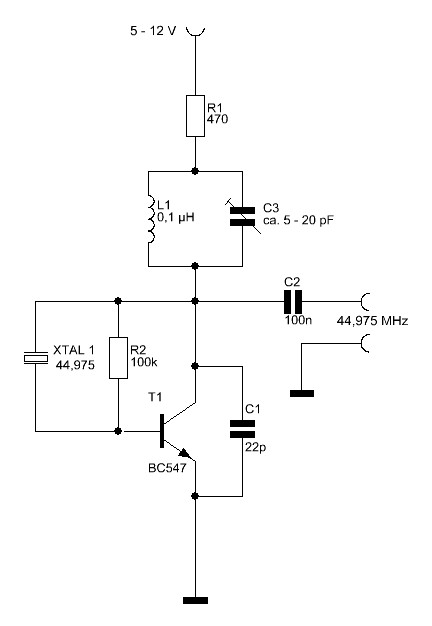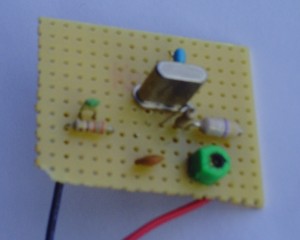For a little 2m band homebrew FM receiver I intent to use channel crystals and a first IF of 10.7 MHz. After a while of thinking I determined taht I want the crystal (xtal) frequency to be defined by the following equation: Fxtal = (Freceive - 10.7 MHz) : 3
For an initial lab test I had a hand full of crystals for the frequency 145.625 MHz available. This frequency is more commonly used across Europe than here in the US. The crystal frequency is 44.975 MHz and the crystal needs to be operated in 3rd overtone mode.
If such a crystal is used in a regular oscillator, like for instance my crystal tester, the crystal will resonate on it’s fundamental frequency and not the intended third overtone.
A little LC tank circuit can be used to get the crystal oscillator on the designated frequency. The tank circuits resonance frequency needs to be equal to the target frequency of the crystal oscillator. The exact frequency is not very critical as long as the resonance frequency is closer to the intended overtone frequency than to the fundamental mode frequency and other overtones.
One possible approach is a series LC-Tank circuit in series with the crystal. This option works with almost every oscillator where the crystal is being used in series resonance.
The option I chose is to modify the crystal tester by adding a parallel LC-Tank circuit to the collector resistor of the circuit.
The oscillator works very reliable and always starts on the third overtone without any difficulties. I tested the circuit between about -20 and +40 degrees Celsius.
My lab model looked something like this:
And the whole thing on a bit of perforated PC-Board:
In case you where wondering where the 2N2222 went, it is mounted on the bottom of the PCB. In place of the 2N2222 one can pretty much use any small signal transistor that is suitable for the target frequency. A 2N2904 or even a BC547 would work as well.
One thing that is interesting to know is the fact that any crystal can be operated on an overtone frequency. A 20 MHz crystal for instance can be used to generate 100 MHz directly. However, I’d like to point out that due to the mechanical properties of a crystal the exact frequency will be slightly off if a fundamental crystal is being operated in overtone mode. The error is fairly small though. The other way around the fundamental frequency of an overtone crystal is a bit off as well.
Westerhold, S. (2012), "Overtone Crystal Oscillator". Baltic Lab High Frequency Projects Blog. ISSN (Online): 2751-8140., https://baltic-lab.com/2012/08/overtone-crystal-oscillator/, (accessed: December 9, 2025).
- WebP-Images without Plugin - January 14, 2025
- Firewall Rules with (dynamic) DNS Hostname - January 14, 2025
- Restoring proxied visitor IPs from Cloudflare - December 26, 2024



mzm
H! How to choose right values of R1 and C4? And how do they need? Are they necessary? I tried the circuit with them and without, have not noticed any difference. But I have a concern that this may affect the noise and other characteristics.
Thanks.